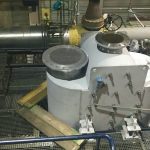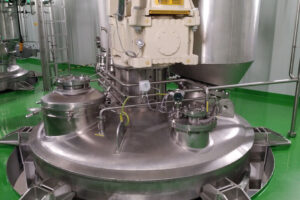Project managers have the task of coordinating all parties (planners, engineers, suppliers, installation companies, etc.) to ensure that an international project is executed on time, on budget, and to the client’s complete satisfaction. In order to find the best possible technical solutions, they therefore prepare comprehensive technical specifications and requirement specifications as well as formalised processes for document approval and technical clarification.
These rules form the framework within which proposal and project engineers, e.g. from component suppliers, operate. During project execution, they are faced with the challenge of finding a feasible way through the plethora of technical and bureaucratic requirements and, at the same time, implementing a technically feasible solution within the agreed time and cost framework. In an international environment, there are often additional cultural factors that may call for the responsible persons to adopt new ways of working.
A structured approach that focuses on the essentials first and then deals with detailed questions has proven its worth. At the same time, it is helpful for those involved to constantly reflect on their own actions and to communicate openly and confidently with all parties. The reward is a successfully completed project and an enrichment of individual professional and personal competencies.
Bidding phase: Stay connected
Tender portals are commonly used internationally, providing important information about the project and enabling communication with the company requesting proposals. Since each platform has its own user interface, familiarisation with the subject-matter can be facilitated by calling the contact person named in the invitation and asking for help and instruction. The same applies to clarifying technical details or content-related questions about the tender text. Here, too, a time-saving telephone call is preferable to a written exchange. For reasons of transparency, a summary of the conversation should always be archived in the portal afterwards.
The fully downloaded documents are searched for relevant specifications, as these are the basis for a realistic offer. The following should be given special attention:
- General design requirements
- Welding and non-destructive testing
- Additional material requirements for use in sour gas applications
- Definition of the scope of Positive Material Identification (PMI)
- Requirements for the manufacturing documentation and required documents for the final documentation (Manufacturing Record Book – MRB)
- Definition of the inspection effort, i.e. scope of the Inspection and Test Plan (ITP) in terms of specified Hold and Witness points for inspections
The benefit of specific offers
The use of supposedly time-saving lump sums for additional specification requirements is not advisable. These usually result in time-consuming inquiries from the customer. Experience has shown that the following topics require additional effort, which should already be considered during the bidding phase:
- Higher effort for non-destructive testing (NDT) – especially RT + UT – compared to applicable regulations
- Higher testing and inspection effort based on different requirements of the customer regarding equipment criticality rating. It is worth searching for terms such as “criticality rating” in the tender documents
- Welding procedure qualifications and/or production weld test specimens on the vessel that go beyond the applicable rules and regulations
- Detailed requirements of the methods, work equipment, and personnel requirements to be used for NDT that can possibly only be met by specialised third-party providers
- High documentation effort for comprehensive Positive Material Identification
- Customer-specific requirements for materials, welding procedures, and test scope for equipment in sour gas applications (gases containing hydrogen sulfide) that exceed NACE MR0175 / ISO 15156 standards, for example
- High required nozzle loads resulting in higher material usage. Verification may have to be performed using calculation methods that require additional software or by means of cooperation with third-party suppliers
The offer that the customer finally receives should clearly state what is technically feasible, what additional costs will be incurred – e.g., through the involvement of third-party providers – or the extent to which extraordinary resources of the company will be required. In addition, the offer should be accompanied by technical comments and – almost more importantly – should include a detailed list of any deviations from the request specification.
Negotiation: Maintain the dialogue
If the customer is interested in the offer, an invitation to technical negotiations will be issued, which is conducted by representatives of the various departments. International projects often involve very stringently working through a formal list in which the project requirements are compared with the submitted offer in detail. The reason for this procedure is that the head of departments have a precisely defined decision-making corridor and are personally responsible for the successful completion of their project.
Deviations from the specification by the bidder must be explained and usually result from the fact that technically unfulfillable requirements could arise if the order is fulfilled to the letter. For the quote creator, it is important to weigh up in the negotiations whether fulfillment of the requirements or withdrawal from the bid is preferable.
In this case, it is practicable to use open and agreement-oriented communication as well as appropriate negotiation. In this way, formulations can be worked out together that describe a technical alternative, but at the same time allow the person responsible on the customer side to confirm that the specification can be fulfilled in a technically reasonable way.
Successful project implementation
If the offer is finally accepted, the individual suppliers must first fill out pre-formatted document lists (master/vendor document list), especially for large projects in the oil and gas sector, and list all documents with designation, document number, and submission date. This can be used very effectively to structure the required production documentation.
It makes sense to start working through the list of production-relevant documents such as drawings, welding plans, parts lists, ITP plans etc. After this, the usually required and less urgent procedures for NDT, colouring, PMI, pressure test etc. are submitted. At the same time, a time schedule for design, document handling, inspections and manufacturing should be prepared.
The document submission is followed by an often time-consuming approval process. EPC (Engineering, Procurement and Construction) companies are responsible for reviewing the enormous volume of documents. Their specialists check the submitted documents in extensive detail for deviations from the required specifications.
In order to achieve technically reasonable solutions within an acceptable period of time, it is important to identify a contact person who can be contacted by telephone. In contrast to the anonymous approval process, detailed questions can be clarified much more efficiently in a personal conversation. Once the approval for all relevant documents has been granted, production starts.
The importance of the Inspection and Test Plan (ITP) should be noted at this point. Typically, a large number of stops are scheduled for inspections with the client’s or EPC contractor’s representatives to monitor production quality and compliance with the agreed tests. These must be notified approximately 10 to 14 days in advance. Missed notifications or non-compliance with deadlines can lead to considerable production delays, and thus penalty claims from the customer.
Conclusion: Minimise time and effort
To better estimate the effort for tender and project engineers seeking to tender in a major international project for the first time, a few things should be kept in mind:
During the bidding and negotiation phases, extensive specification requirements are to be expected, which often go beyond the usual applicable sets of rules. Since the processes for creating and approving manufacturing documentation and for inspection notifications are anonymised and formalised, it is important to ensure strict compliance with them. This often requires a considerable amount of additional time. If deviations from the technical specification are unavoidable, suitable solutions must be developed together with the customer in a timely manner.
Also important are technical competence, communication skills, and an open and approachable personal relationship with others.
Online search: VAU Thermotech
Hall 4.0, Booth F46











